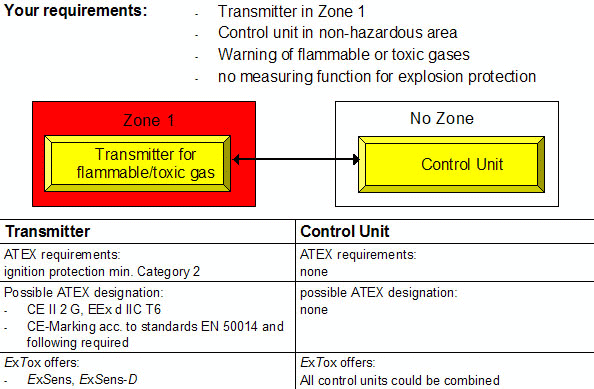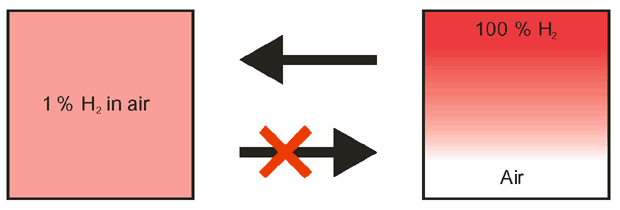General Information
Biogas Analysis:
Measured Gas Lines
Ammoniaküberwachung in Kälteanlagen
Verfügbare und vertretbare Meßtechnik
Gesundheitsgefahren durch CO2 und H2S
toxische Wirkung von Schwefelwasserstoff und Kohlendioxid
Biogasanalyse (Veröffentlichung)
Hinweise zur Biogasanalyse
Raumluftüberwachung (Veröffentlichung)
Hinweise zur Raumluftüberwachung in Biogasanlagen
ATEX
ATEX for Gas Detection Systems – Easy to understand!
Gas detection systems are very often used in hazardous areas and are subject to regulations applicable to such areas. Middle of the year 2003 all these individual regulations have been fixed for Europe under Directive 94/9/EU - better known as ATEX.
The user classifies first all hazardous areas into Zone 0, 1 or 2 by means of a risk analysis. The grade of hazard decreases from Zone 0 to Zone 2. You could use detection systems within these zones which correspond to the minimum re- quirements of the ATEX. The different requirements of the Zones are reflected in corresponding Device Categories (see Picture 1).
In most of the cases the requirements refer to the so-called ignition protection that means measures to prevent the device from causing an explosion.
The safe measuring function may complete the requirements of a gas detection system for flammable gases. You have to keep in mind that in this case also the control unit of the gas detection system is subject to the ATEX regulations although it is not installed in hazardous areas itself. That has to be taken into consideration every time you integrate the measuring function into your safety concept.
The labelling on the gas detection system as well as the manufacturer’s EC Declaration of Conformity stating the Directive 94/9/EU and the corresponding standards give information on whether the system is suitable for installation in hazardous areas. The ignition protection refers to the standards EN 50014 (and following) and the safe measuring function refers to EN 50054 (and following) and EN 61779. For detection systems of Categories 1 and 2 an EU-Type examination and production monitoring by notified bodies such as for example PTB, BAM or EXAM are mandatory. For detection systems of Category 3 a manufacturer’s declaration is sufficient.
The following examples cover the main applications.



In case of any question or problem please do not hesitate to contact us. We are glad to assist you.
Installation sites
Installation place of transmitters
The Legend of light and heavy gases
Often the following rule of thumb is taken into consideration when selecting theinstallation place:
- Gases lighter than air ascend, therefore the measuring elements are mounted near the ceiling.
- Gases (or vapours) heavier than air sink, therefore the measuring elements are mounted near to the floor.
We would like to show you why in most of the cases the maximum potential of protection of the gas detection system is not completely used or it might even come to dangerous situations when following this rule of thumb. But we have to look into the properties of gases and vapours first.
To classify gases and vapours as lighter or heavier than air derives from the specific weight of the pure components. Hydrogen, methane and ammonia are mainly lighter than air. All other components, especially higher hydrocarbons, are generally heavier than air.
The extension mechanisms derived from the rule of thumb mentioned above are only valid for undiluted components - this means, a gas concentration of 100 Vol.-% supposed.
The use of gas detection systems serves for monitoring of undesired components at very low concentrations. On the field of explosion protection the ranges of concentrations are below 5 % (v/v), whereas the ranges for toxic gases are in ppm and much lower.
There is no real difference in specific weight between gas mixtures with such low concentrations and ambient air. Therefore their extension does not depend on the up- or down-draft of the gas, but on other streaming influences, such as wind or thermal lift.
A mixture of gas and air is not split into its fractions – as wrongly supposed sometimes- in case a mixture has already taken place (Fig. 1). This effect – known for example from water / oil mixtures – does not appear on gases.
The general situation is shown in Fig. 2. Pure gas which is lighter than air emerges out of a leakage into the environment. For the first instance the updraft prevails and the gas cloud rises.
By means of swirling and diffusion the gas is mixed with air. As the up-draft is more and more reduced, the stream prevails and carries the gas with it. In the described situation the gas detection unit installed in position A as per rule of thumb would not monitor the gas release or it would react too late.
In this case it would be much better to install the device in position B - in case in combination with lower alarm levels to take the higher dilution into consideration. If the potential sources of release could be further narrowed down, the sensor element should alternatively be installed near to the source (position C).
Case 1: Rule of Thumb is a bad solution
Situation: Inside a big labour at a working place it is worked with hydrogen which is taken from a pressure gas bottle. Leakages of the bottle or of the tubes should be monitored with a gas detection system.
Rule of Thumb: The transmitter should be placed near the ceiling.
Better solution: The transmitter is placed centrally only slightly above the working place.
Reason: With a leakage pure hydrogen emerges and rises first. At the same time the hydrogen is mixed with the ambient air. With that, up-draft and concentration decrease. Mixtures containing hydrogen reach the transmitter near the ceiling later in comparison with those above the working place. The alarm level is reached later additionally.
Maintenance
Maintenance of Gas Detection Systems
Usefull Links
 |
GESTIS-database on hazardous substances
Information system on hazardous substances of the German Social Accident Insurance |
 |
Equipment intended for use in potentially explosive atmospheres
|
 |
Electromagnetic compatibility - EMC
|
 |
LVD |
 |








